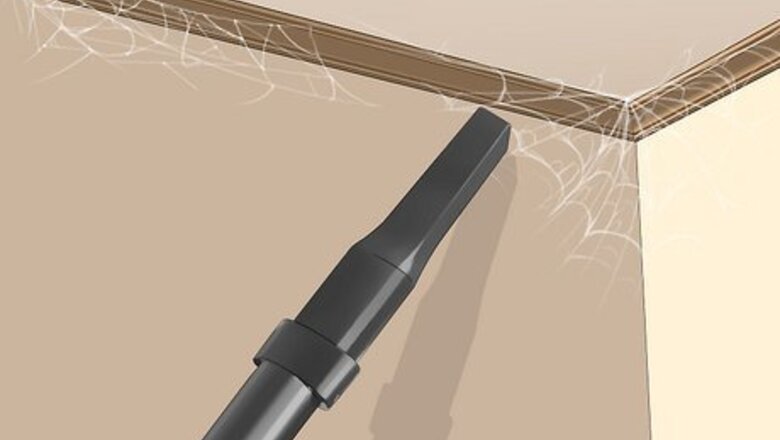
views
- Use your vacuum to suck up black widow spiders and webs around your home. Alternatively, spray them with vinegar or pyrethroid pesticides.
- Move firewood, trash, and other yard debris away from your home. Spray the perimeter with an insecticidal barrier to keep black widows from coming in.
- Seal cracks and gaps in your home’s exterior with caulk or mesh screen to keep spiders out. Regularly clean and declutter to keep black widows from building webs.
Getting Rid of Black Widows Indoors
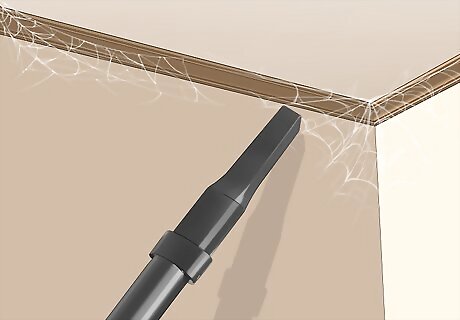
Suck the spiders and webs up with your vacuum. Use the hose attachment on your vacuum to reach the black widow spiders without getting too close. Check in dark corners and crevices that are undisturbed, like in the basement, attic, closet, or garage. Simply point the hose nozzle at any spider or web you find. The black widows won’t survive the powerful suction from your vacuum cleaner. When you’re finished, take the vacuum bag out or empty the filter immediately into a garbage bag. Tie the bag tightly and place it in the trash outside. Before you start looking for black widow spiders, put on thick gardening gloves, closed-toe shoes, long sleeves, and denim pants to protect yourself. Black widow spiders are usually more active on their webs at night, so wait until later in the evening to search for them.
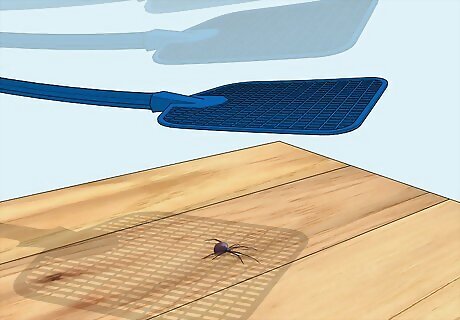
Squash any black widows you find with a flyswatter or heavy shoe. Put on a pair of thick gloves and closed-toed shoes before you start. When you find a black widow spider, slap it with a flyswatter or shoe. After you kill the black widow, wipe up the residue with a paper towel and all-purpose cleaner to disinfect the surface. Black widows aren’t aggressive and will run away instead of fighting back if you miss them. Luckily, they aren’t very fast and you’ll have another chance to kill them.
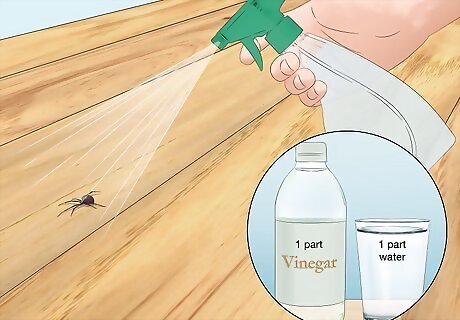
Try spraying black widows with vinegar for a natural pesticide. Fill a spray bottle with a solution that’s half distilled white vinegar and half water. When you find a black widow spider, mist the spray directly onto them. The acetic acid in the vinegar will hurt and kill the spiders quickly. Vinegar spray may also work as a deterrent to other black widows and spiders.
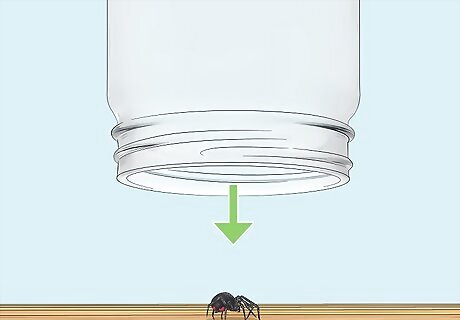
Catch black widows in a glass jar to release them outside. Black widow spiders are beneficial for hunting other pests and insects on your property, so you don’t have to kill them. Wear a thick pair of gloves and long sleeves. Put a large glass jar over the black widow and slide a piece of paper over the opening. Quickly flip the jar right-side up so the spider can’t crawl back out. Then, take the spider at least 100 feet (30 m) from your home to prevent it from coming back in. Point the jar away from you when you let the black widow go so it doesn’t crawl back toward you.
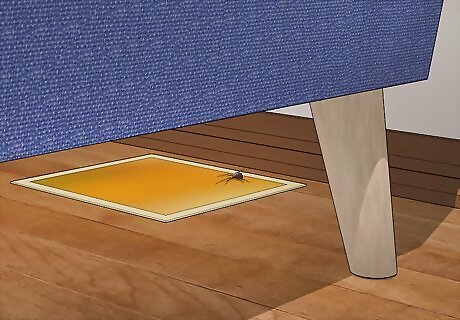
Put down sticky traps to catch and kill spiders. Set the adhesive traps along the baseboards of your home near dark corners or underneath furniture. If a black widow goes into the trap, it will get stuck on the adhesives and starve. Every few days, check the traps for spiders. If the traps are full, then toss them out and put out new ones. Sticky traps are non-toxic, so they’re safe to use around children. Just keep pets away so their fur doesn’t get stuck in the adhesive. Sticky traps also catch other pests and insects that black widows feed on. Because you’re removing their food source, the spiders may find a new habitat.
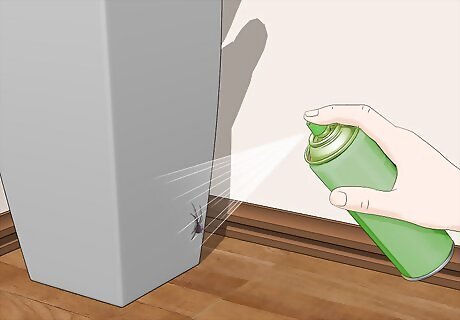
Spray pyrethroid pesticide directly onto spiders and webs. Look for a pesticide that’s labeled to kill spiders since it will be the most effective. Put on a dust mask and spray the corners or crevices where you’ve seen black widows. If you see any spiders, apply the pesticide to them directly to kill them instantly. Let the spray dry completely, and reapply them every few weeks. Application instructions may vary between pesticides, so always follow the directions on the package you get. Pyrethroids can be harmful to children and pets while it’s wet, so keep them away from treated areas until they dry completely.
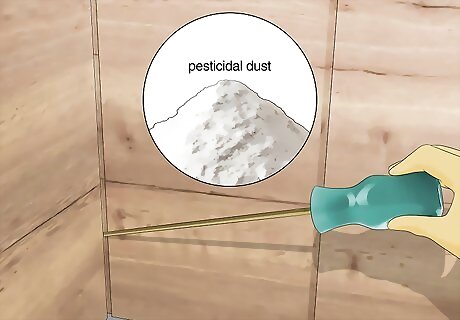
Apply pesticidal dust to cracks or crevices where spiders may hide. Put on a dust mask so you don’t inhale any of the pesticides while you’re spreading them. Load a hand duster with the pesticides, and apply it into cracks, crevices, and openings in your wall. When spiders come into contact with the dust, they’ll die on contact. The dust will also prevent new spiders from moving in. Dust applications are best for out-of-the-way places where the dust won't be disturbed by anyone but the spiders. This includes attics, basements, and crawl spaces as well. Try using diatomaceous earth for a natural alternative. Diatomaceous earth is made up of small sharp pieces that cut into the spider’s body and dehydrate it.
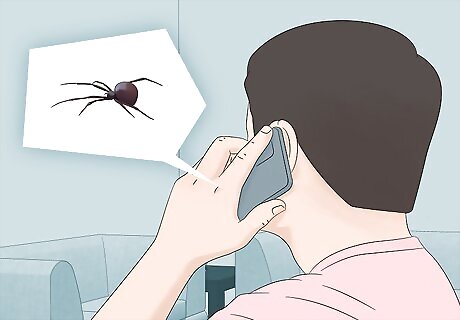
Call a professional exterminator if you have a large infestation. While it’s normal for a few black widow spiders to find their way inside, a large number of them is a sign of a larger problem. Reach out to a professional and let them know about the issue so they can effectively and efficiently eliminate the entire black widow population. An exterminator will have the specialized equipment necessary to access hard-to-reach places where black widows nest. Contact multiple pest control agencies first to ensure that they are adequately equipped to deal with black widow infestations and to quote prices. Hire an exterminator if you have small children, elderly people, or pets living with you because they’re more likely to get seriously sick from a black widow bite.
Controlling Black Widows Outdoors
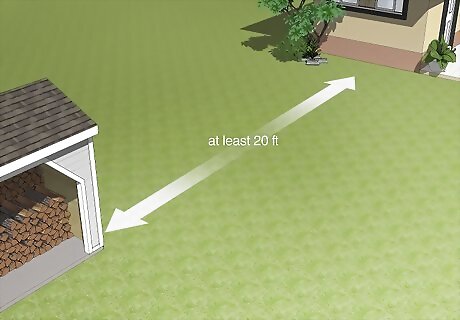
Move firewood or other debris away from your home’s foundation. Black widow spiders build their nests in wood piles, trash areas, rock walls, and any other dark, sheltered areas that are undisturbed. Put on a thick pair of gloves before cleaning up around the outside of your home. Move wood piles and other items at least 20 feet (6.1 m) away from your home so black widows are less likely to come inside. When wood and nesting sites are further from your home, it’s less likely for the spiders to find their way inside.

Trim your lawn and other vegetation in your yard. Spiders often make their homes in long grass or under plant cover, so keep your lawn cut short by mowing it once a week. Trim vines growing on the walls so spiders can’t climb them to get inside. Then, cut back bushes growing on or near exterior walls so they’re about 1 foot (30 cm) away.
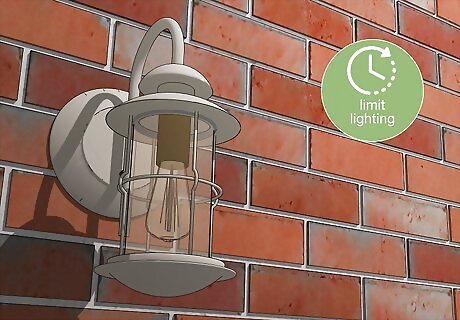
Limit your use of outdoor lights. Bright outdoor lights can attract flying insects that black widows feed on, so they’ll stick around for a steady supply of food. Turn off your outdoor lights when you don’t need them so there isn’t as much prey for the spiders. If you do want to keep exterior lights on, switch to yellow light bulbs because they’re less likely to attract insects. Keep your curtains closed at night so your indoor lighting doesn't attract more insects outside.
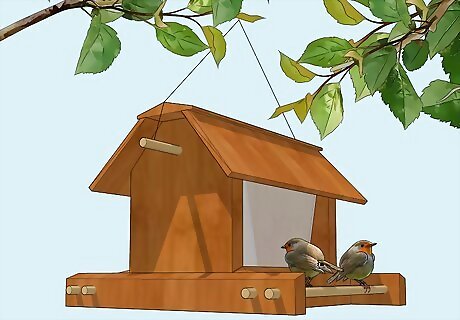
Encourage natural predators to live in your yard. Birds like wrens are natural predators of bugs and spiders, including the black widow. Attract more birds to your garden by putting up bird feeders, installing nest boxes, and adding native plants to your garden. Provide a small dish of water as well so the birds can bathe and drink. With more birds in the area, spiders are less likely to call your yard their home. Mud dauber wasps also prey on black widow spiders. These large solitary bugs look like other wasps, but they rarely sting humans and aren’t dangerous. They hunt black widows, so leave them be if you see them flying around or building a nest nearby.
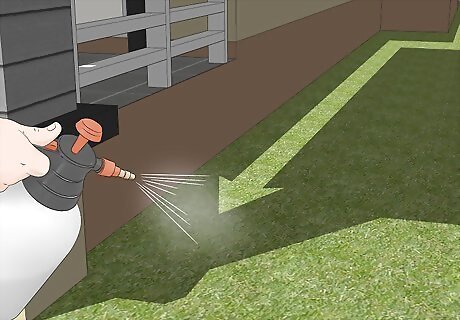
Apply a pesticidal barrier around your home’s exterior. Put on a face mask so you don’t breathe in any of the spray. Hold down the trigger on the spray wand and spread the barrier so it extends 1 foot (30 cm) up and out from the wall. When black widows come into contact with the barrier, they’ll absorb the pesticides and die. Reapply the barrier every month, or as often as the directions recommend. Keep pets and children away from pesticidal barriers until they’ve completely dried to avoid any lung irritation. Pesticidal barriers also help kill insects that black widows prey on so they’re less likely to build webs near your home.
Preventing Black Widow Spiders
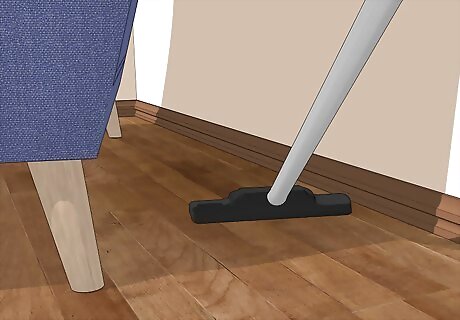
Regularly clean your home to prevent black widow nests. Black Widow spiders like to be left undisturbed, which is why they often choose dark, neglected corners to hide out in. Plan on cleaning your home on a regular schedule. Sweep and vacuum at least once a week, making sure to clean in dark corners, under furniture, and inside closets. If you have black widows under window ledges or around door frames, wash the outside of your home with a jet attachment on your hose. This will flush out any spiders, especially from hard-to-reach places like upper-level windows.

Reduce clutter indoors and outdoors. Built-up clutter provides a safe haven for black widow spiders to build their webs. Clear out old boxes in storage areas, declutter your closet, and take out any trash. Move your items away from the wall so black widows have fewer places to hide. If you have to keep any boxes, make sure they’re taped shut and sealed tightly so black widows don’t find their way inside. Take out trash and get rid of debris in your yard so spiders don’t have as many nesting places. Put on a pair of thick gloves and closed-toe shoes if you’re cleaning up clutter to protect yourself from potential black widow bites.
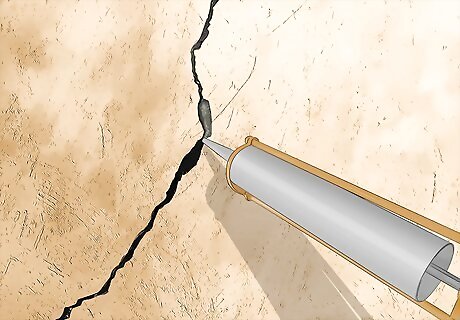
Seal any cracks, crevices, or openings where spiders could get inside. Despite the fact that Black Widows are relatively large spiders, they can still manage to squeeze through very small cracks. Search around your home’s exterior for any cracks or gaps in the foundation, like near entryways, windows, or exterior pipes. Fill the openings with caulk to keep black widows from coming in. If you notice any damaged screens on windows or doors, patch or replace them. For gaps around windows and underneath doors, attach weatherstripping to fill in the gaps. Apply some pesticidal dust inside of the crevice before filling it in. If there are still spiders inside, the dust will kill them.
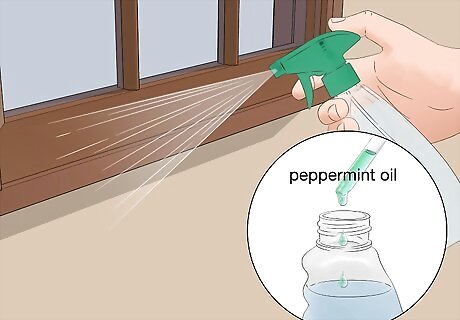
Try spraying a peppermint oil repellent. Black widows are sensitive to the strong scent of peppermint oil, so they’ll build their webs somewhere else. Fill a spray bottle with water and add a few drops of the peppermint oil. Spray the oil around your home, especially in corners and dark areas where black widows like to hide. Reapply the spray weekly to help keep the spiders away. Try leaving chestnuts around your home, on the windowsill, and in tight corners because the chemicals they contain may repel spiders. You may try using lemon essential oil or lemon peels, but it may not be effective at keeping spiders away.
Identifying Black Widow Spiders
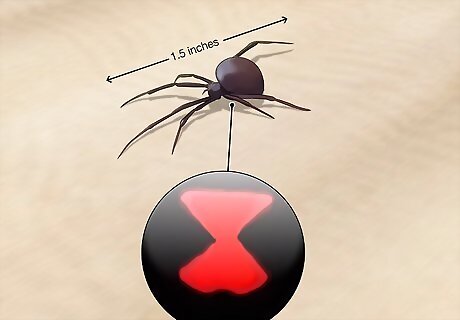
Recognize black widow spiders by their black body and red hourglass marking. Black widow spiders are found around the world, and they are the most venomous spiders in North America. Female black widows are about 1 ⁄2 inches (3.8 cm) long and have a shiny black body with a large spherical abdomen. Their abdomen typically has a signature red hourglass mark, but it may look like a red stripe or have no marking at all. Male black widows are about half the size of the female and have brown or grey bodies. They have several red dots on their abdomens and may have a yellow or red band across their backs. Male black widow spiders are not venomous or dangerous to humans. Young black widows, known as spiderlings, are white or yellow-white when they first hatch, but darken as they grow. Male and female spiderlings look the same, but they’re both harmless to humans when they’re young.
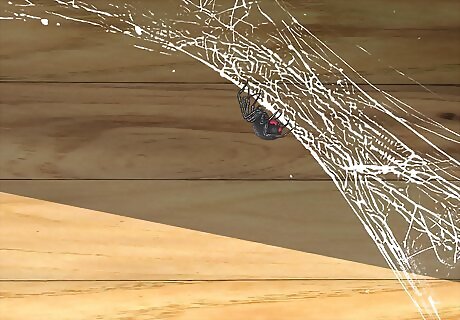
Check for irregularly-shaped sticky webs in dark, dry places. Black widow spiders make their home in dark, protected areas, such as in boxes, between pieces of firewood, and under ledges. Inside, they’ll stay in dark areas where they won’t be disturbed, like under furniture or in the basement and attic. Look for their webs within 1 foot (30 cm) of the ground. Rather than building a symmetrical web, black widow webs are slightly erratic and cross in multiple directions. The strong silk may make a slight ripping noise if you tear the web apart. Black widows may also hide under vehicles, even if they’re driven periodically. Check for webs near the tires, or around the engine.

Look for pea-shaped egg sacs near nesting sites. Black widows lay their eggs inside thick sacs spun from their silk. The egg sacs are about the size of a large pea and look like fluffy cotton balls. Each egg sac can contain 200–300 black widow eggs. Black widows usually leave egg sacs in their webs, but they may be in a corner or undisturbed area nearby. Avoid crushing the egg sac because spiderlings may escape and spread throughout your home. Vacuum them up instead.
Treating a Black Widow Bite
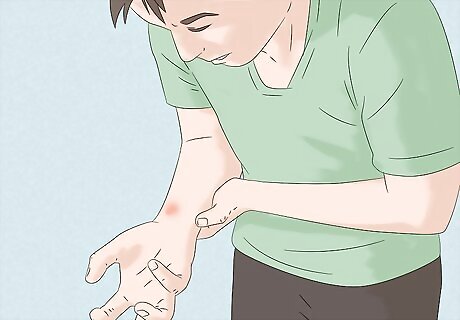
Watch for pain, swelling, nausea, and sweating if you were bitten. Only female black widow spiders are venomous, and they’ll only bite if they feel threatened or trapped. You’ll know if you’re bitten if you feel a sharp pain right away and see swelling and redness. As the neurotoxin in the venom spreads over the next few hours, it may cause spasms of pain, cramping, headache, sweating, and nausea. Even though black widows have a strong venom and can make you feel sick, their bites are rarely deadly and you’ll usually feel better within the next few days. Small children and elderly people are much more susceptible to adverse reactions when bitten by a Black Widow. Medical treatment should be sought immediately. In rare cases, black widow bites may cause tremors or convulsions, but this can normally be avoided with medical treatment.
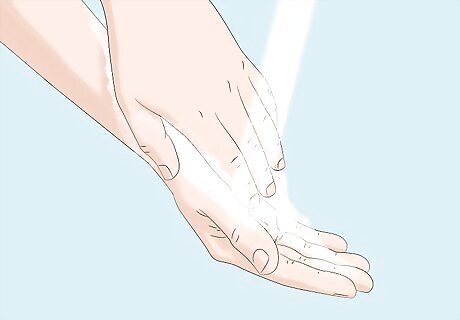
Wash the bite with soap and water immediately. Rinse off the bite under running water and wash it off with mild hand soap to remove any bacteria or venom on the surface. Apply an antibacterial ointment to the bite right after you wash it to help prevent any further infections. Reapply antibiotic cream 3 times a day.
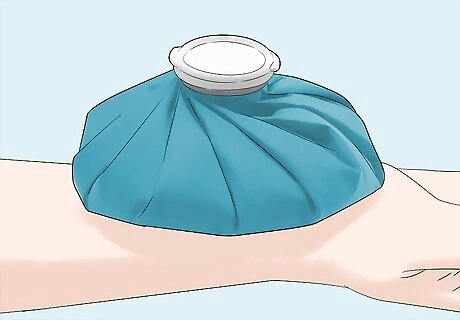
Put an ice pack on the bite and elevate the area. Wrap an ice pack in a towel and hold it against the bite to help ease some of the pain and bring down the swelling. Try to keep the bite elevated as well so the bite doesn’t get swollen and to keep the black widow venom from working through your system.
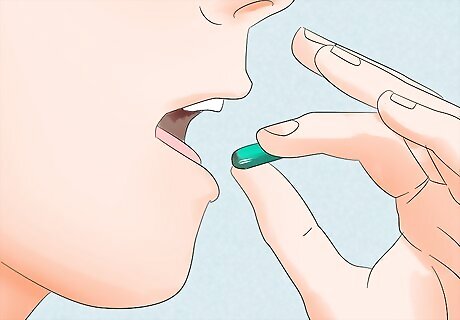
Use over-the-counter medication to ease pain and itchiness. It’s normal for your muscles to ache and the bite to itch while the venom works through your body. Take a pain reliever as well as an antihistamine to help manage your symptoms so they’re not as noticeable.
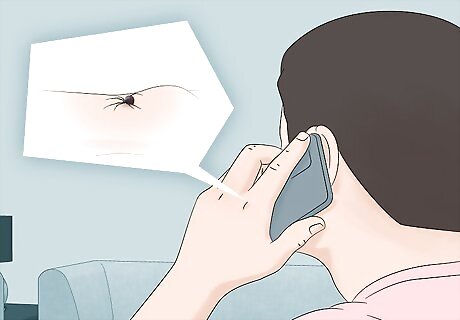
Contact your doctor as soon as possible for further treatment. Once you initially treat the spider bite, contact your doctor and let them know what happened. Tell them any symptoms you’ve experienced so far so they can recommend any next steps. Depending on the severity of the bite, your doctor may prescribe muscle relaxants or pain relievers. If you’re experiencing serious symptoms, then contact the emergency room. They may give you antivenin to counteract the spider’s venom.
















Comments
0 comment